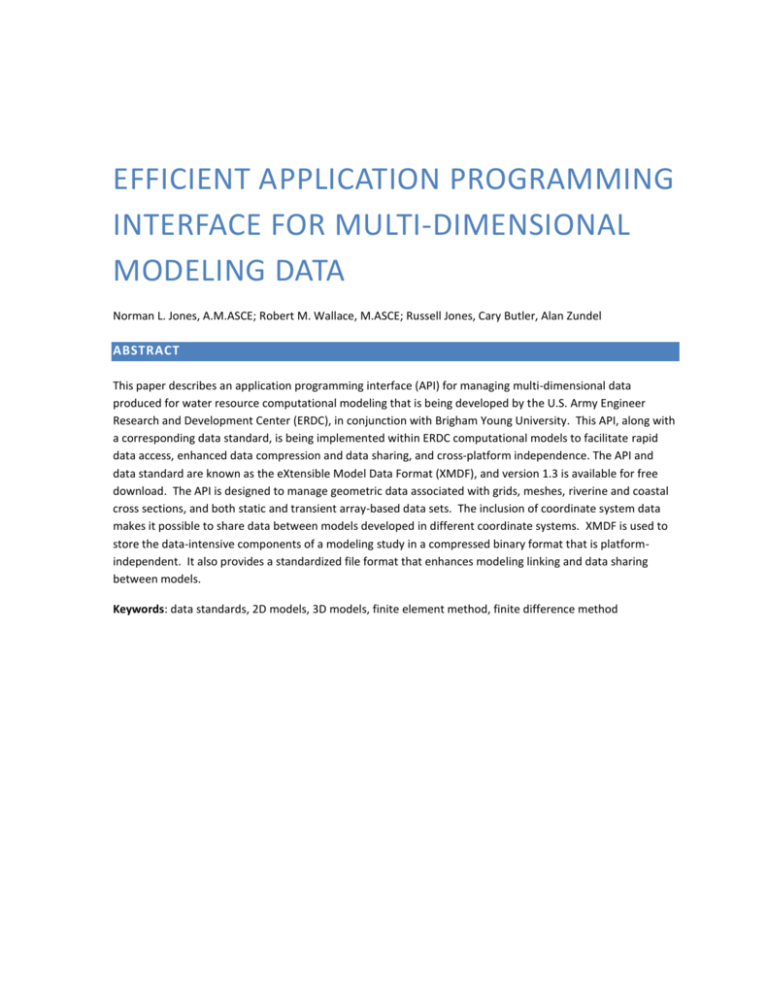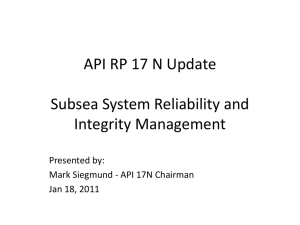A Comparison of Three-Dimensional Interpolation Techniques for
advertisement

EFFICIENT APPLICATION PROGRAMMING INTERFACE FOR MULTI-DIMENSIONAL MODELING DATA Norman L. Jones, A.M.ASCE; Robert M. Wallace, M.ASCE; Russell Jones, Cary Butler, Alan Zundel ABSTRACT This paper describes an application programming interface (API) for managing multi-dimensional data produced for water resource computational modeling that is being developed by the U.S. Army Engineer Research and Development Center (ERDC), in conjunction with Brigham Young University. This API, along with a corresponding data standard, is being implemented within ERDC computational models to facilitate rapid data access, enhanced data compression and data sharing, and cross-platform independence. The API and data standard are known as the eXtensible Model Data Format (XMDF), and version 1.3 is available for free download. The API is designed to manage geometric data associated with grids, meshes, riverine and coastal cross sections, and both static and transient array-based data sets. The inclusion of coordinate system data makes it possible to share data between models developed in different coordinate systems. XMDF is used to store the data-intensive components of a modeling study in a compressed binary format that is platformindependent. It also provides a standardized file format that enhances modeling linking and data sharing between models. Keywords: data standards, 2D models, 3D models, finite element method, finite difference method TABLE OF CONTENTS Abstract ..................................................................................................................................................................1 Introduction ............................................................................................................................................................4 Previous Work ........................................................................................................................................................4 Design Objectives ...................................................................................................................................................4 Ease of use/implementation ..............................................................................................................................4 Efficiency ............................................................................................................................................................4 Platform independence ......................................................................................................................................5 Support of multiple languages ...........................................................................................................................5 Application Programming Interface .......................................................................................................................5 Data Types Supported ............................................................................................................................................5 Meshes ...............................................................................................................................................................5 Grids ...................................................................................................................................................................6 Cross-Sections ....................................................................................................................................................6 Array-Based Properties.......................................................................................................................................6 Data Sets .............................................................................................................................................................6 Organization ...........................................................................................................................................................6 Conclusions .............................................................................................................................................................7 Acknowledgements ................................................................................................................................................7 References ..............................................................................................................................................................7 TABLE OF FIGURES Figure 1 Interface Layering Between Applications and Disk Storage using XMDF and HDF5 API’s ..................13 Figure 2 Element Types Supported in XMDF. ...................................................................................................14 Figure 3 Cross-Section Data. (a) Riverine Cross-Sections. (b) Coastline Cross-Sections. ..................................15 Figure 4 Mesh Group Layout.............................................................................................................................16 INTRODUCTION One of the more costly aspects of any computational modeling effort is the management of data. A conservative estimate is that more than fifty percent of an entire modeling effort is involved with obtaining, cleaning, transferring, and manipulating data files. The problem is exacerbated during large, multi-dimensional projects where multiple investigators, multiple data sources, and long project duration can create complicated and expensive data management problems. The US Army Corps of Engineers (USACE) is particularly sensitive to data management issues because it is a large organization that hires multiple contractors to obtain and manipulate data for modeling projects. Reducing the effort required to work with data by adopting common data standards can significantly reduce the overall costs of a modeling project. PREVIOUS WORK Other efforts have been conducted to produce a common data standard for water resource modeling. A few of the more recent of these efforts are discussed in the following sections. ArcHydro – ArcHydro was developed by a consortium of industry, government, and academia researchers as a GIS-based data structure that links hydrologic data to water resource models and decision-making methods. HEC-DSS – The U.S. Army Engineer Hydrologic Engineering Center (HEC) Data Storage System, or DSS, is a database designed to efficiently store and retrieve scientific data that are typically sequential. NetCDF – NetCDF (Network Common Data Form) is a set of interfaces for array-oriented data access and a freely distributed collection of data access libraries for C, Fortran, C++, Java, and other languages. The NetCDF libraries support a machine-independent format for representing scientific data. DESIGN OBJECTIVES In the design of XMDF, it was determined that the following features would be essential to the success of the project: EASE OF USE/IMPLEMENTATION The success or failure of any attempt at standardization will ultimately be judged by how widespread within the targeted organization the protocol is adapted. EFFICIENCY Perhaps the most important factor in ensuring widespread usage of XMDF is to provide numerous performance benefits beyond the data sharing benefits to be derived from the usage of a common file format. If the XMDF tools result in more efficient modeling code, model developers will be further motivated to adopt the standard. PLATFORM INDEPENDENCE The files written to the XMDF standard must be compatible with both the UNIX and PC platforms. Data written to one platform must be readable from the other platform. SUPPORT OF MULTIPLE LANGUAGES The tools associated with the file formats must be accessible from multiple programming languages. At a minimum, the C/C++ and FORTRAN languages must be supported. APPLICATION PROGRAMMING INTERFACE After careful consideration of these design goals, it was concluded that XMDF should be delivered as an API rather than a prescribed file format. The API approach satisfies many of the design goals listed previously. An API is easy to implement since the model developer can focus on a simple set of subroutines and functions to store and retrieve the data rather than writing the file I/O code from scratch. The API allows for performance enhancements since complex functionality such as data compression and bit-swapping for binary file input/output (I/O) can be hidden behind the API. The API also allows for data abstraction since the API is, by definition, an interface designed to hide implementation details. The XMDF API is built on top of the HDF5 library as illustrated in Figure 1. The model data are stored on disk using the HDF5 format. The low-level file I/O is handled with the HDF5 API. The XMDF API is built on top of the HDF5 API and provides a simpler interface to the data. For example, the XMDF API includes a set of simple subroutines for saving a finite element mesh. These XMDF subroutines receive the finite element data and then use the native HDF5 API and subroutine calls to store the data into the low-level hierarchal structure utilized by HDF5. The XMDF API provides a buffer between the model codes and the low-level HDF5 library. This buffer makes the file format easier to implement and maintain. DATA TYPES SUPPORTED Theoretically, all data associated with a computational model could be stored in XMDF/HDF5 format. However, converting the entire set of source code related to file I/O to the XMDF format would require a substantial amount of work for each model and would not be necessary in order to achieve the benefits associated with XMDF. Rather, XMDF is used to store the subset of the model data that is the bulkiest and requires the most disk storage. This subset includes the model geometry, array-based properties, and solution data (data sets). Model geometry includes meshes, grids, and cross-section data. MESHES XMDF supports 1D, 2D, and 3D finite element meshes. Both the element topology and nodal coordinates are saved to the file. Since some models utilize elements of different dimensions in a single simulation, any combination of element types can be combined in a single file. Each element type is identified by a code. The element types currently supported in XMDF are shown in Figure 2. These represent the types most commonly used in water resource modeling. It is anticipated that additional types may be added in the future based on feedback from users. GRIDS The types of grids supported in XMDF are illustrated in Table 1. Both 2D and 3D grids are supported. The computational points can coincide with the cell corners, centers, or faces. Grids can be rotated with respect to the global XYZ axes, and the relative orientation of the rows, columns, and layers (IJK axes) can be userdefined. 2D grids can be either Cartesian or curvilinear. 3D grids can be Cartesian, curvilinear, or extruded 2D grids. CROSS-SECTIONS Cross-section data are associated with commonly used 1D river and coastal model such as HEC-RAS, and WSPRO (HEC-RAS, 2001; Shearman, 1990). Cross-section data define channel bathymetry and profile (longitudinal) lines that can be used to represent centerline, bank line, or other “stream” paths within a stream channel or coastline (Figure 3). Line (material properties) and point (thalweg, bank) properties associated with cross-sections are stored as well as other attributes. ARRAY-BASED PROPERTIES In addition to model geometry, XMDF provides a simple mechanism for storing array-based model properties such as hydraulic conductivity or roughness coefficients. These arrays can be floats, double precision floats, integers, or strings. DATA SETS A data set is similar to an array-based property except that each item can be either a scalar or a vector and data sets can be either steady state or transient (one array per time-step). Data sets are generally used for model solutions. Scalar data sets have one value for each entity in a mesh or grid. Vector data sets may have either two (x, y) or three components (x, y, and z) depending on whether the data are 2D or 3D. ORGANIZATION Data are organized in an XMDF file in a hierarchical fashion using “groups”. A group is similar in concept to a folder or directory on a file system. Each group represents an unstructured mesh (or set of scattered data points), a structured grid (either Cartesian or curvilinear), or a set of cross-sections. Each of these groups may include one or more subgroups with property arrays or data sets. A sample mesh group is shown in Figure 4. The ability to organize data in a hierarchical fashion is one of the basic features of the HDF5 library, upon which XMDF is built. However, the file structure is automatically organized by the XMDF API. The user simply needs to pass the data to the XMDF API using the FORTRAN/C interface. CONCLUSIONS This paper presents a new API for storing data associated with water resource modeling studies. This API is built upon HDF5 and is a generic way to describe multi-dimensional numeric model data and associated data sets and properties. The XMDF format/API provides a number of benefits: A common data format makes it easy to share data between models and pre- and post- processing tools. Prior to this effort, an expensive burden was placed upon pre- and post- processors to support multiple, modelspecific file formats. Due to the use of HDF5, the API automatically performs conversions for numeric and string formats due to platform, precision, and language inconsistencies. Big/Little endian conversions are performed for platform independence. Floats can be automatically converted from between different orders of precision (i.e. 32-bit to 64-bit float). Strings are automatically converted based upon how they are stored in C versus FORTRAN. The API is designed to maintain backward compatibility. The library performs versioning automatically so data files do not become unusable in the future. The API interface makes it possible to adopt the format with minimal effort and the HDF5 based format results in substantially faster file I/O and much smaller file sizes. The XMDF API and documentation can be downloaded free of charge (XMDF, 2008). ACKNOWLEDGEMENTS This work was funded by the U.S. Army Engineer Research and Development Center in Vicksburg, Mississippi. Permission to publish this paper was granted by the Chief of Engineers. REFERENCES SDSFIE (2008). “Spatial Data Standards - Release 2.60.” Spatial Data Standards for Facilities, Infrastructure and the Environment Steering Group. <https://www.sdsfie.org/ > (Feb 29, 2008). EMRL (2008a). Groundwater Modeling System (GMS), Version 6.0, Environmental Modeling Research Laboratory, Brigham Young University, Provo Utah. EMRL (2008b). Surface Water Modeling System (SMS), Version 9.0, Environmental Modeling Research Laboratory, Brigham Young University, Provo Utah. EMRL (2008c). Watershed Modeling System (WMS), Version 7.1, Environmental Modeling Research Laboratory, Brigham Young University, Provo Utah. FGDC (2008). The Federal Geographic Data Committee, <http://www.fgdc.gov> (Feb 29, 2008). GeoVRML (2008). “GeoVRML.org.” Web3D Consortium, <http://www.ai.sri.com/geovrml/> (Feb 29, 2008). Harbaugh, A.W., E.R. Banta, M.C. Hill, and M.G. McDonald. (2000). MODFLOW-2000, the U.S. Geological Survey modular ground-water model -- User guide to modularization concepts and the Ground-Water Flow Process: U.S. Geological Survey Open-File Report 00-92. United States Geological Survey, Reston, VA. HDF5 (2008). “HDF5 Home Page,” National Center for Supercomputing Applications, University of Illinois. <http://hdf.ncsa.uiuc.edu/HDF5/> (Feb 29, 2008) HEC-DSS (2008). “HEC-DSS Introduction.” US Army Corps of Engineers Hydrologic Engineering Center, <http://www.hec.usace.army.mil/software/hec-dss/hecdss-dss.html> (Feb 29, 2008). HEC-RAS (2001). HEC-RAS River Analysis System Hydraulic Reference Manual Version 3.0. US Army Corps of Engineers, Institute for Water Resources Hydrologic Engineering Center, Davis, California. ICE (2008) “Interdisciplinary Computing Environment.” Army Research Laboratory, <http://www.arl.hpc.mil/ice> (Feb 29, 2008). Maidment, D.R. (2002). ArcHydro: GIS for Water Resources, ESRI Press, Redlands, California. NetCDF (2008). “NetCDF FAQ.” Unidata, <http://my.unidata.ucar.edu/content/software/netcdf/faq.html> (Feb 29, 2008). SEDRIS (2008). “The Source for Environmental Representation and Interchange.” SEDRIS, <http://www.sedris.org/> (Feb 29, 2008). Shearman, J.O. (1990). Users Manual for WSPRO - A Computer Model for Water Surface Profile Computations, Report No. FHWA-IP-89-027, Federal Highway Administration, Denver, Colorado. 187 p. XMDF (2008). “XMDF on XMS WIKI”, Aquaveo,. <http://www.xmswiki.com/wiki/XMDF> (Feb 29, 2008). XMSF (2008). “Extensible Modeling and Simulation Framework.” MOVES Institute, Naval Postgraduate School, <http://www.movesinstitute.org/xmsf/xmsf.html> (Feb 29, 2008). Yeh P.S., X.S. Wei, L. Miles, B. Kobler, D. Menasce, (2002) "Implementation of CCSDS Lossless Data Compression in HDF," Proceedings of the Earth Science Technology Conference–2002, 11–13 June 2002, Pasadena, California. (http://esto.nasa.gov/conferences/estc-2002/Papers/A3P2(Yeh).pdf) Table 1 Grid Types Supported in XMDF Type Description Mesh-Centered Computational points are located at the corners of the grid cells. (2D & 3D) Cell-Centered Computational points are located at the centers of the grid cells. (2D & 3D) Face-Centered Computational points are at the centers of the faces of the grid cells (2D & 3D) Cartesian Row, column, and layer boundaries are orthogonal (2D & 3D) Sample Table 2 Relative performance of compression algorithms using a Pentium II 300 MHz processor on a 343 MByte block of data (Yeh, et al., 2002). Type Compress Time (s) Decompress Time (s) Ratio RLE 85.7 41.6 1.6 Adaptive Huffman 558.4 574.9 2.28 Gzip 273.1 38.3 2.37 Szip 71.6 63.6 2.8 Table 3 XMDF Performance – Finite Element Meshes Size (MB) 2D/3D # Nodes # Elem ASCII XMDF XMDF C1* 2D 8,060 15,786 0.9 0.6 0.3 2D 1,002,001 1,000,000 74.7 58.7 11.9 3D 169,260 315,720 25.4 16.4 5.4 3D 4,000,080 7,582,640 453.1 376 126 *Compression level = 1 (out of nine available levels) Table 4 XMDF Performance – Data Sets Size (MB) . # Pts Transient ASCII Binary XMDF XMDF C1 10,000 No 0.09 0.04 0.05 0.04 250,000 No 0.7 0.9 1 0.1 6,160 Yes 2.2 1 1 0.5 Applications (GUI’s, Model Codes, etc.) XMDF API HDF5 API Disk Storage Figure 1 Interface Layering Between Applications and Disk Storage using XMDF and HDF5 API’s Linear 1D Quadratic 1D Transition 1D Linear Triangle Quadratic Triangle Linear Quadrilateral 8-node Quadratic Quadrilateral 9-node Quadratic Quadrilateral Linear Tetrahedron Linear Prism Linear Hexahedron Linear Pyramid Figure 2 Element Types Supported in XMDF. (a) (b) Figure 3 Cross-Section Data. (a) Riverine Cross-Sections. (b) Coastline Cross-Sections. Figure 4 Mesh Group Layout





